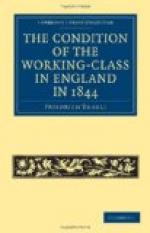Precisely similar is the testimony of Dr. Ray, for eighteen years physician in the hospital in Leeds: {153a}
“Malformations of the spine are very frequent among mill-hands; some of them consequent upon mere overwork, others the effect of long work upon constitutions originally feeble, or weakened by bad food. Deformities seem even more frequent than these diseases; the knees were bent inward, the ligaments very often relaxed and enfeebled, and the long bones of the legs bent. The thick ends of these long bones were especially apt to be bent and disproportionately developed, and these patients came from the factories in which long work-hours were of frequent occurrence.”
Surgeons Beaumont and Sharp, of Bradford, bear the same testimony. The reports of Drinkwater, Power, and Dr. Loudon contain a multitude of examples of such distortions, and those of Tufnell and Sir David Barry, which are less directed to this point, give single examples. {153b} The Commissioners for Lancashire, Cowell, Tufnell, and Hawkins, have almost wholly neglected this aspect of the physiological results of the factory system, though this district rivals Yorkshire in the number of cripples. I have seldom traversed Manchester without meeting three or four of them, suffering from precisely the same distortions of the spinal columns and legs as that described, and I have often been able to observe them closely. I know one personally who corresponds exactly with the foregoing description of Dr. Ray, and who got into this condition in Mr. Douglas’ factory in Pendleton, an establishment which enjoys an unenviable notoriety among the operatives by reason of the former long working periods continued night after night. It is evident, at a glance, whence the distortions of these cripples come; they all look exactly alike. The knees are bent inward and backwards, the ankles deformed and thick, and the spinal column often bent forwards or to one side. But the crown belongs to the philanthropic manufacturers of the Macclesfield silk district. They employed the youngest children of all, even from five to six years of age. In the supplementary testimony of Commissioner Tufnell, I find the statement of a certain factory manager Wright, both of whose sisters were most shamefully crippled, and who had once counted the cripples in several streets, some of them the cleanest and neatest streets of Macclesfield. He found in Townley Street ten, George Street five, Charlotte Street four, Watercots fifteen, Bank Top three, Lord Street seven, Mill Lane twelve, Great George Street two, in the workhouse two, Park Green one, Peckford Street two, whose families all unanimously declared that the cripples had become such in consequence of overwork in the silk-twisting mills. One boy is mentioned so crippled as not to be able to go upstairs, and girls deformed in back and hips.




